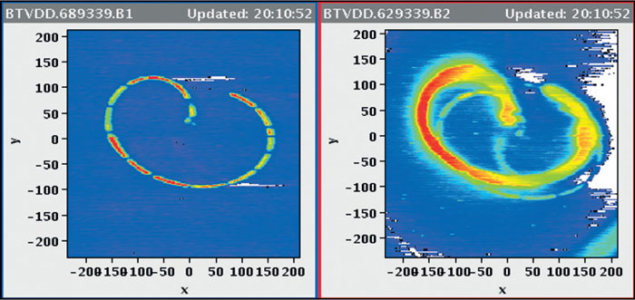
In the last beam period before a two-year shutdown, the LHC began 2013 with a challenge: proton–ion collisions. Following a trial run in September, the machine went into full operation beyond its design specification, producing head-on collisions of protons with lead nuclei from mid-January to mid-February. At 5 TeV per colliding nucleon pair, the gain in collision energy is a factor of 25 above previous collisions of a similar type, making it one of the largest such gains in the history of particle accelerators.
Commissioning this new and almost unprecedented mode of collider operation was a major challenge for both the teams behind the LHC and its injector chain. The LHC configuration had to be modified quickly before and during the short run to achieve a number of physics goals.
Nonetheless, on 11 January, single bunches of protons and lead nuclei were injected into the LHC and successfully ramped to full energy. Over the following night the LHC-operations and beam-physics teams sprang into action to commission and measure the optics through a completely new sequence to squeeze the beams at collision. Interventions on the power and cryogenics systems slowed down the commissioning plan but by 20 January stable beams had been achieved with 13 bunches per beam.
In the next fill of the machine, the first bunch-trains were injected, leading to stable beams with 96 bunches of protons and 120 of ions. This important fill allowed the study of “moving”, long-range beam–beam encounters. Stationary long-range encounters occur in proton–proton or lead–lead runs, when bunches in the two beams “see” one another as they travel in the same vacuum chamber on either side of the experiments. The situation becomes more complicated with proton–lead collisions because the long-range encounters move as a result of the different revolution times of the two species – a key feature of proton–lead operation.
At injection energy, lead ions travel more slowly than protons and complete eight fewer turns a minute round the LHC (674,721 turns compared with 674,729 turns for protons). As a result, the two beams – and their RF systems – run independently at different frequencies. Once the energy has been ramped up, the frequency differences become small enough for the RF systems to be locked together in a non-trivial process known as “cogging”.
During the first cogging exercises, high beam-losses triggered beam dumps. This was later found to be caused by an improper synchronization of the two RF frequencies, and careful fine-tuning of the cogging process overcame the problem. After the cogging exercise and throughout the physics fill, the beams run “off-momentum” with opposite offsets to their orbits, requiring special corrections of the beam optics.
The full filling-scheme with 338 bunches in both beams was injected and successfully ramped on 21 January. In addition, the teams achieved a record lead-bunch intensity in the LHC thanks to the excellent performance of both the machine and the injectors. From 24 January onwards the machine was running routinely with stable beams of 338 bunches of protons in ring 1 (clockwise) and lead ions in ring 2. On 1 February, the beams were swapped so that ALICE, inherently an asymmetrical detector, could take data in both directions. A number of issues with cogging and squeezing made this beam reversal challenging, with the machine providing collisions between 192 ion bunches with 216 proton bunches for some days before the operators attempted to reach 338 bunches in each beam by the end of the run on 11 February.
Despite the short time-frame of this asymmetrical run, all seven LHC experiments were able to take data. On a good day, fills had peak luminosity at the beginning of the collisions of around 1029 s–1 cm–2 in ALICE, ATLAS and CMS. Integrated luminosity was well above expectations at around 2 nb–1 a day for each of these experiments. This bodes well for the experimental analysis that will continue to go from strength to strength as the LHC enters its first long shutdown to consolidate and improve this impressive machine.







